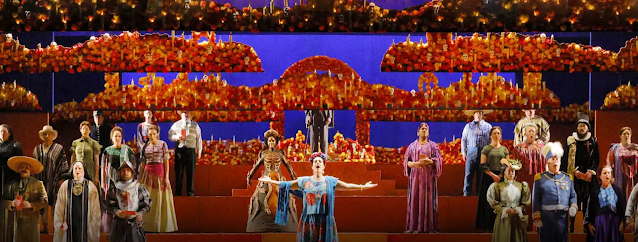by Ernest Hogan
We had to check out the San Andreas Fault, that keeps rattling California but still hasn’t managed to sink the state the way it was supposed to back in the early Seventies. The Golden State doesn’t seem to be destined to be a new Atlantis, but then the Pacific plate whose northward movement causes the dreaded earthquakes is more likely a chunk of lost Lemuria.
Not far from the fault is the remarkable and somewhat Lemurian town of Parkfield, population 18. It’s the home of the University of California Berkeley Seismological Laboratory–a metal shack that seems to be home to some machines--and a bluegrass festival, though there isn’t much room for a big crowd. There’s the Parkfield Lodge that wasn’t open, guarded by a wooden Indian and a monument to the Yokut, the local Indigenous tribe. and some fanciful buildings and odd structures that could well be Lemurian plumbing fixtures.
Back on the road Mike asked about the word “logistics” on trucks. Then we looked it up: the detailed coordination of a complex operation. Hmm. I pretended to answer a phone: “Mysterious Logistics, what can we do for you?” We all laughed.
Then I saw some roadside datura.
We checked into a motel in Monterey–the bathroom in our room had a sign with a Tralfamadorian heretic reminding us not to flush “flushable” wipes.
We felt like Mexican food. I like to eat Mexican while on the road, not just too feed my addiction, but to see what kind of variations on the theme are going on as the virus spreads. The young woman with orange/purple hair and a lip piercing recommended El Milagro down the road in Seaside, her personal favorite. Her family was from Oaxaca and their menu was Oaxaqueño. We went for it.
It had some nice murals and Día de los Muertos decorations, and the food was great. Not the generic Mexican fare you find in most of Aztlán. They didn’t have my old, beloved,reliable tacos, beans, and rice, so I went for their tacos and a cold cactus salad. The taco was what I would call a burrito, and the salad was made with nopales, known in the Anglophones as prickly-pear. It was made from the paddles, not the fruit. I usually have nopales fried, and with eggs and salsa for breakfast, but the salad was a new treat.
A lot of the customers, and the employees, were from Oaxaca. The manager was impressed that I had been to Oaxaca, and knew about Zapotecan culture. There seems to be a Zapotecan colony there.
Mexican immigration to California has changed over the years. Decades ago it was mostly people from the border states–like my family, on both sides–and some from as far south as Mexico City.
In recent years, we’ve come to see an influx from the south, where tamales are wrapped in banana leaves. These days the Pacific Coast Highway now bristles with Mexican restaurants boasting a diverse selection of cuisines.
And there are so many of them. I thought that my hometown–Glendale, Arizona–had a higher density of them than parts of Mexico, but this, I'm afraid to say, blows us out of the water.
So many Mexican restaurants, so little time. I’m going to have to come back someday.
The next morning, I found a news story about scientists discovering the Law of Increasing Functional Information. More information, even if it’s in the form of molecular structure, triggers evolution.
And here it’s happening with La Cultura.
Later at a Pacific Grove thrift store, I found a copy of Cortez and Montezuma by Maurice Collis. The guy who rang me up told me his name was Quetzalcoa, dropping the “tl” like a modern Nauhuatl speaker.
The functional information keeps coming. Maybe some mysterious logistics are in order.
Ernest Hogan’s first short story collection, Guerrilla Mural of a Siren’s Song, is available on Amazon. What are you waiting for?



































